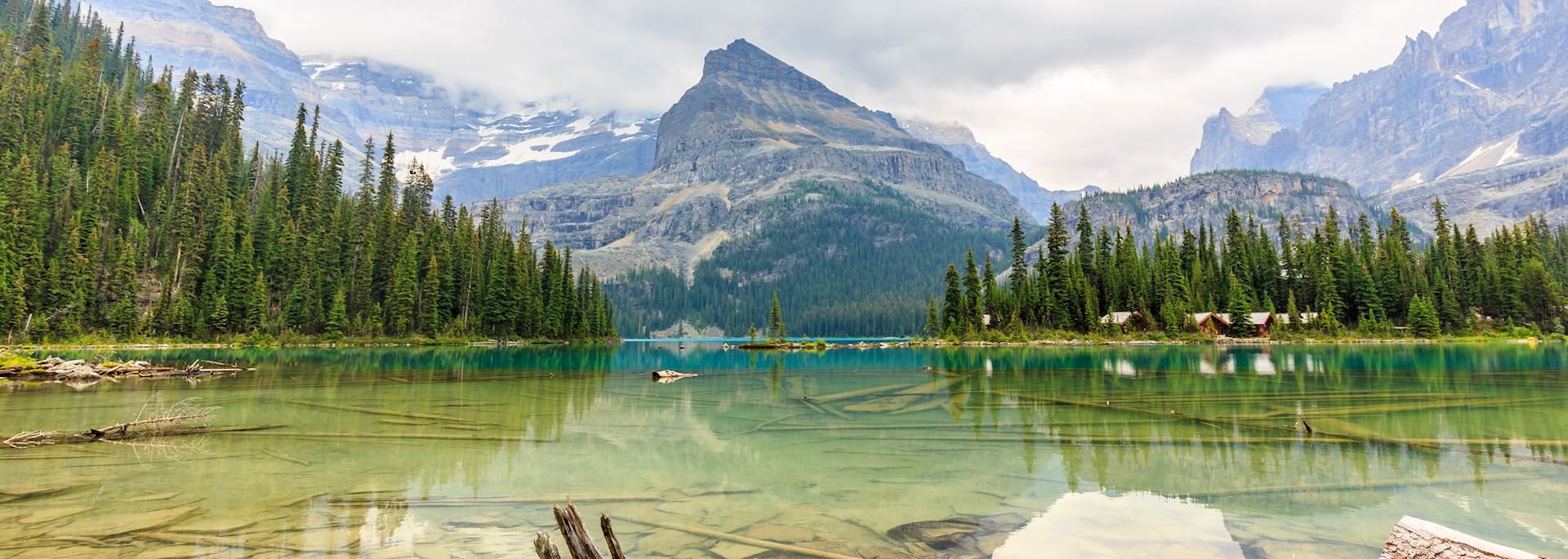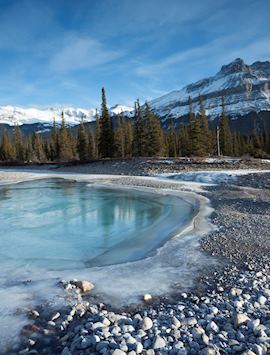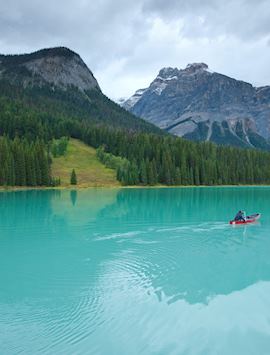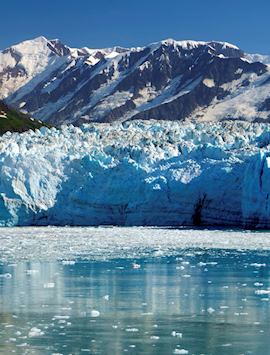By Canada specialist Emily
Driving out of Jasper along the Icefields Parkway, I couldn’t help stopping to admire the view. It’s difficult to grasp the scale of the Rocky Mountains until you’re surrounded by them, their sharp peaks layered one in front of the other like a pop-out card.
A trip to the Rockies isn’t about cramming in as much as possible, it’s about putting on a waterproof and a pair of boots and just getting out there, pausing to watch a passing elk or moose, gazing up at some of the world’s darkest, star-crowded skies (occasionally graced by the northern lights), and wandering away from the busier spots to find your own secluded tract of land.
How to explore the Canadian Rockies

Outside of the winter months (when flying or coach journeys are safer), self-driving is your best option for getting around. It means you can travel at your own pace, dictating where you stop to take in views or explore places that pique your interest.
You could visit the Rockies as part of a wider trip across western Canada, beginning or ending in Vancouver with stops in-between at Whistler and Wells Gray Provincial Park. Alternatively, you could fly directly into Calgary, just a two-hour drive from Banff. There are also several train routes that cross the Rockies.
As the main routes through the Rockies get busy during the summer months, I also recommend following a quieter loop that takes you from Calgary to Waterton Lakes National Park, on the US border, and through small mountain towns like Fernie, Nelson and Golden.
You can also add on time in the Okanagan Valley wine region and switch Banff and Jasper National Parks for lesser-visited options like Kootenay, Yoho and Glacier National Parks. Read more about this route through the Rockies in our guide to self-driving western Canada.
When to visit the Canadian Rockies

June to September is the main travel season, but to avoid the crowds I prefer visiting in late September, when the landscape is dappled bright yellow from the changing leaves of larch and aspen trees. At this time, visitor numbers have thinned out, but you can still enjoy the same activities before temperatures plummet.
I also like visiting in May — while lakes are sometimes still frozen at this time, meaning some activities are off-limits, the snow-covered mountain peaks create a dramatic backdrop and visitor numbers are still relatively low. As May turns to June, everything becomes vivid green and wildflowers spring up.
In winter, everywhere is much quieter, the landscape is transformed by snow and you have a whole new set of activities to choose from — you can read about some of them in our guide to active winter experiences.
Highlights of the Canadian Rockies
Jasper National Park
Jasper town

The alpine town of Jasper is situated in the heart of the national park, set against a backdrop of huge mountains. It’s compact enough to explore on foot, with a good range of restaurants, bars and shops.
It’s mainly used though as a gateway for enjoying the park’s outdoor activities, from hiking, canoeing and white-water rafting along the Athabasca River, to taking a guided motorcycle ride in a Harley-Davidson sidecar.
Close to the town is the Jasper SkyTram, which takes you to the top of Whistlers Mountain. Standing at an altitude of 2,500 m (8,100 ft), the views in front of you stretch for miles, encompassing the town, distant mountains that seem to be shrugging off wispy clouds, and lakes gleaming blue and silver in the sun.
Maligne Valley and Maligne Lake

Many of the park’s natural highlights lie within Maligne Valley, 15 minutes northwest of the town. I suggest taking a guided trip out to explore them, stopping first at Maligne Canyon, a 50 m (160 ft) deep gorge carved by the Maligne River over the course of 10,000 years. Taking a short walk to the canyon’s rim, you can see the river flowing through and a series of waterfalls gushing down the limestone rock face.
Next you visit Medicine Lake. Formed by meltwater flooding the valley in spring, it dries up completely as the temperature rises. It’s a pretty spot at any time of year thanks to the steep-sloped mountains and bottle-green firs on all sides.
For me, though, the highlight of the valley is Maligne Lake. This is the quintessential Canadian lake, whose smooth, aquamarine waters lap the shores of Spirit Island — a tiny islet with huddled trees that forms one of the most photographed views in the Rockies.
You can take a 90-minute boat cruise around the lake and up to the island, looking out for ospreys diving to catch fish. Kayaks and canoes can also be hired — I find it impossible to visit the Rockies without taking up a paddle.
Walking in Jasper National Park

I headed out with a guide to learn more about the history, geology and wildlife in this part of the Rockies, but the park’s many walking trails are easy to navigate if you want to explore independently. Maps are available from the park’s information points.
I like the 3.2 km (2 mile) Mary Schaffer Loop, which takes you around the shores of Maligne Lake to a viewpoint above, before winding through pine forest. The trail is named after the park’s first official visitor, who arrived in the area in 1908. You can learn about her explorations through the interpretive displays set up along the trail.
For a tougher challenge, the 9 km (5.6 mile) Path of the Glacier trail takes you up to Mount Edith Cavell — one of the most prominent peaks in the Rockies — and rewards you with close-up views of several glaciers. You also pass Cavell Glacier, where chunks of ice occasionally fall with a splash into the milky-turquoise waters of Cavell Pond. You’ll also see the Angel Glacier, which resembles an angel with outspread wings.
Where to stay in Jasper National Park

I like staying at Alpine Village Cabin Resort because you have the best of both worlds — you’re only 2 km (1.2 miles) from central Jasper, but can enjoy the classic ‘cabin-in-the-woods’ experience. The stone and pine log cabins, each featuring a private terrace, are set among the trees close to the river and can sleep up to five guests.
Icefields Parkway

I’d never have thought that a day of driving would turn out to be the highlight of my trip. But the journey south from Jasper to Banff along the 232 km (144 mile) Icefields Parkway is no run-of-the-mill road trip.
While, taking the parkway, you could arrive in Banff after just four and a half hours, you’ll pass so many tempting viewpoints and walking trails that your journey time can easily double — I’d urge you to blank out a whole day. You can read more about the drive and its highlights in our guide to the Icefields Parkway.
Banff National Park
Banff town

Banff is the flagship town of the Rockies, watched over by towering mountains in the middle of the park. It was the area’s natural hot springs that first attracted people here over a century ago, and you can still take a soak in the warm mineral waters at Banff Upper Hot Springs.
I found Banff was busier than Jasper, with a good choice of restaurants and shops. Calgary’s airport is just two hours away. Its central location in the park gives you easier access to the quieter areas, as well as the lesser-visited Kootenay and Yoho National Parks.
Lake Louise and Moraine Lake

In summer, people head to Lake Louise for a walk or to navigate the calm turquoise waters by canoe or paddleboard. In winter the lake freezes over, and the canoeists are replaced by ice skaters. Despite the lake’s popularity, it’s possible to walk a few minutes from the car park and find relative solitude.
You could then head just 20 minutes up the road to explore Moraine Lake, whose natural beauty also draws in visitors. Its water is even more vivid, pooled at the foot of huge, steeply rising mountains.
Moraine Lake Lodge has the best setting of any hotel I’ve stayed at. After a technology-free night in one of the log cabins, I was able to explore the lake in the early morning and late afternoon when no other visitors were around. You can rent canoes from the lodge’s boathouse, or take guided walks with the resident naturalist.
Walking in Banff National Park

From Lake Louise, I followed the 3.4 km (2.1 mile) Lake Agnes trail to a friendly teahouse on the shores of nearby Lake Agnes, where far fewer people tend to venture. The trail is fairly steep in places, but offers views over Lake Louise and nearby Mirror Lake, which is much smaller. The teahouse is a worthy reward, stocking over 100 varieties of loose-leaf tea and plenty of cake.
Setting off from Banff town, you can follow the 4.3 km (2.7 mile) Tunnel Mountain Trail, which winds up 300 m (984 ft) through pine forest to a viewpoint at Banff’s lowest summit. Again, the trail is quite steep in places, but well maintained and signed. At the top, stop to take in a panorama of the town and the Bow and Spray River Valleys.
Another route I recommend is the 10 km (6.2 mile) Bow Falls to Hoodoos Trail. Following the banks of the Bow River, you can stop to watch the falls and turbulent rapids frothing over rocks and boulders. The walk is relatively flat, much of it through forest, but the highlight is reaching the hoodoos — otherworldly spires of rock sculpted by the wind.
Where to stay in Banff National Park

Rather than staying in Banff, I base myself in the smaller town of Canmore, half an hour southeast. This peaceful town has several B&Bs, including my personal choice, Ambleside Lodge. Its living room has floor-to-ceiling windows overlooking the mountains, and there are just three guest rooms, so it feels like a home.
Lesser-known highlights of the Canadian Rockies
Kootenay National Park

Just over the provincial border, Kootenay National Park fringes Banff National Park but sees far fewer visitors. Following trails through the same mountain and lake scenery, it often felt like I had the whole park to myself. There’s also more chance of spotting wildlife such as elk, moose, deer and bears.
The park has several natural springs you can visit, including the Paint Pots — a collection of iron-rich springs that bubble up to the surface, creating orange, yellow and green pools and turning the ground rusty red. There’s also Radium Hot Springs, a pool complex where you can bathe in warm natural spring waters.
Cross River Cabins

Tucked away on the southern edge of the park, Cross River Cabins is a place where guests wish they could spend an extra night. The epitome of seclusion, it’s hidden at the end of a long gravel track with mountains looming large in the near distance.
Just a handful of log cabins are dotted among the pine trees, and the main lodge has a wood-fired hot tub. There’s an emphasis on sustainability here, and the Patenaude family who own the property are keen to ensure it has minimal impact on its surroundings.
From the property, you can head out with experienced local guides along some of the area’s hiking trails, formed from old animal trails or logging roads and generally unknown. There are several rivers nearby for canoeing, kayaking, white-water rafting or fishing.
Waterton Lakes National Park

In the far southwest corner of Alberta, Waterton Lakes National Park borders the USA’s Glacier National Park, and together they form the first international peace park. This protected landscape of glacial valleys, mirror-smooth lakes, and vivid wildflower meadows is an under-the-radar alternative to the Rockies’ headline areas, and you’ll often find its network of trails relatively devoid of other visitors. We’ll share our tried-and-tested walks, or you can head to the park’s visitor centre for trail maps.
Mountains swoop down to meet the shimmering blue water, which you can explore by kayak or on a boat trip, looking out for moose quenching their thirst on the shore. Follow trails through thick forests that shelter wildlife like elk, white-tailed deer, bighorn sheep, and black bears. Or, you can drive the Bison Paddock Loop Road for an age-old view of bison grazing on the expansive prairies, with a backdrop of mountains rising abruptly in the distance.
Start planning your trip to the Canadian Rockies
Start thinking about your experience. These itineraries are simply suggestions for how you could enjoy some of the same experiences as our specialists. They're just for inspiration, because your trip will be created around your particular tastes.
View All Tours in Canada



